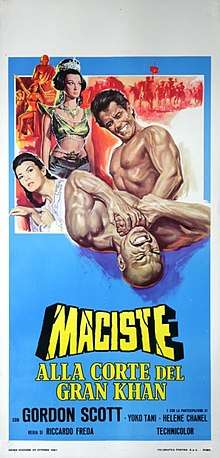Maciste alla corte del Gran Khan
| Maciste alla corte del Gran Khan | |
|---|---|
 | |
| Directed by | Riccardo Freda |
| Produced by | |
| Screenplay by | |
| Story by | Oreste Biancoli[1] |
| Starring | |
| Music by | Carlo Innocenzi |
| Cinematography | Riccardo Pallotini[1] |
| Edited by | Ornella Micheli[1] |
Production companies |
|
| Distributed by | Jolly Film |
Release date |
|
Running time | 94 minutes[1] |
| Country |
|
| Box office | ₤468.2 million |
Maciste alla corte del Gran Khan also known as Samson and the Seven Miracles of the World and Maciste at the Court of the Great Khan is a 1961 Italian/French international co-production starring Gordon Scott. The film reused the sets, extras and Yoko Tani as a princess from Marco Polo (1961) and Freda's The Mongols (1961). The film was distributed in North America by American International Pictures who changed the identity of the title character from Maciste to Samson. AIP released the film as a double feature with Warriors Five.
Plot
In his eternal wandering Maciste finds himself in 13th Century China rescuing a Chinese prince and princess from the Tartars and leading the Chinese into a revolt against them.
Cast
- Gordon Scott as Maciste (Samson in the American version)[1]
- Yoko Tani as Princess Lei-ling
- Hélène Chanel as Kiutai
- Dante Di Paolo as Bayan
- Gabriele Antonini as Prince Cho
- Leonardo Severini as Garak
Production
After the enormous popular success of Hercules , producers and screenwriters began developing other films about muscular heroes performing amazing feats.[2] Most were drawn from literary figures or the Bible, while Maciste was an Italian creation who first appeared in Cabiria (1914).[2] Producer Ermanno Donati thought of the idea of resurrecting Maciste for new audiences, as his brother Piero Donati explained.[2] The producers first shot the film Maciste nella valle dei re.[2]
Freda's film Maciste alla corte del Gran Khan was whas was called a "film di recupero" in Italy, meaning a recovery film.[2] The film was created in order to earn money from the expensive epic Marco Polo - L'aveentura di un italian in Cina.[2]
Release
Maciste alla corte del Gran Khan was released in Italy on October 31, 1961 where it was distributed by Jolly Film in Rome and Unidis throughout Italy.[1] The film grossed 467.2 million Italian lire on its theatrical release.[1] The film was released theatrically in the United States as Samson and the 7 Miracles of the World.[3] The American version of the film was distributed by American International Pictures and had its score changed from Carlo Innocenzi to one by Les Baxter.[1]
Reception
This film has been evaluated as being among director Riccardo Freda's "better" contributions to the peplum genre. [4]
References
Footnotes
Sources
- Bondanella, Peter E. (2009). A History of Italian Cinema. London - New York: International Publishing Group. ISBN 978-1441160690.
- Hughes, Howard (2011). Cinema Italiano - The Complete Guide From Classics To Cult. London - New York: I.B.Tauris. ISBN 978-1-84885-608-0.
- Curti, Roberto (2017). Riccardo Freda: The Life and Works of a Born Filmmaker. McFarland. ISBN 1476628386.
- Paul, Louis (2005). Italian Horror Film Directors. McFarland. ISBN 978-0-7864-8749-3.